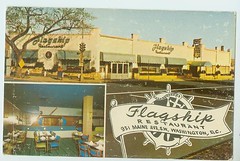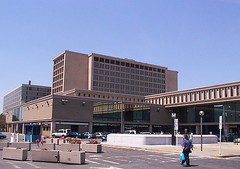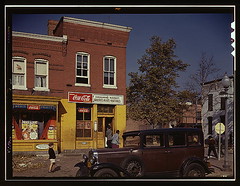Southwest Waterfront Post story
 Pre-Phillips postcard view of the old Flagship Restaurant on the Anacostia waterfront.
Pre-Phillips postcard view of the old Flagship Restaurant on the Anacostia waterfront.In "Southwest Waterfront Will Finally Get Over the '60s," the Post reports on new plans to remake the unsuccessful Southwest Waterfront. This is relevant to the previous article on freeways, and John King's San Francisco Chronicle article, 15 Minutes that Changed San Francisco: The sweeping makeover that transformed the city began 15 years ago today with the Loma Prieta earthquake," is perhaps even more relevant to the opportunities presented by the Anacostia waterfront. From the Post article:
The team, which prevailed in a field of 17, wants to connect the waterfront to the community, making it more of a destination. Some dead-end street would become through streets. Parking lots would be replaced by parks, condominiums and offices. The walled-off waterfront would be more accessible to the public with piers, a maritime museum, shops, restaurants and perhaps an aquarium. The crumbling concrete sea wall would be replaced by a promenade along the waterfront.
"We want to integrate the waterfront with the community," said Monty Hoffman, founder and chief executive of PN Hoffman. His company is partnering with Struever Bros. Eccles & Rouse, which has experience on revitalization projects along Baltimore's waterfront and throughout that city.
Finally there is some learning about the relative failure of urban renewal, that traditional urban design and vital streets are the way to go.
 Waterfront Mall is typical of the modernist, urban renewal program that denuded the southwest quadrant of people and vitality at the street level. Photo by BeyondDC.
Waterfront Mall is typical of the modernist, urban renewal program that denuded the southwest quadrant of people and vitality at the street level. Photo by BeyondDC. Urban renewal at Virginia Avenue and 7th Street SW. Photo: Washington Star collection, Washingtonia Room, MLK Library.
Urban renewal at Virginia Avenue and 7th Street SW. Photo: Washington Star collection, Washingtonia Room, MLK Library. Shulman Market. Early 1940s. Photo: Louise Rosskam, OWI-FSA photo collection, Library of Congress.
Shulman Market. Early 1940s. Photo: Louise Rosskam, OWI-FSA photo collection, Library of Congress.Index Keywords: urban-design-placemaking



0 Comments:
Post a Comment
<< Home